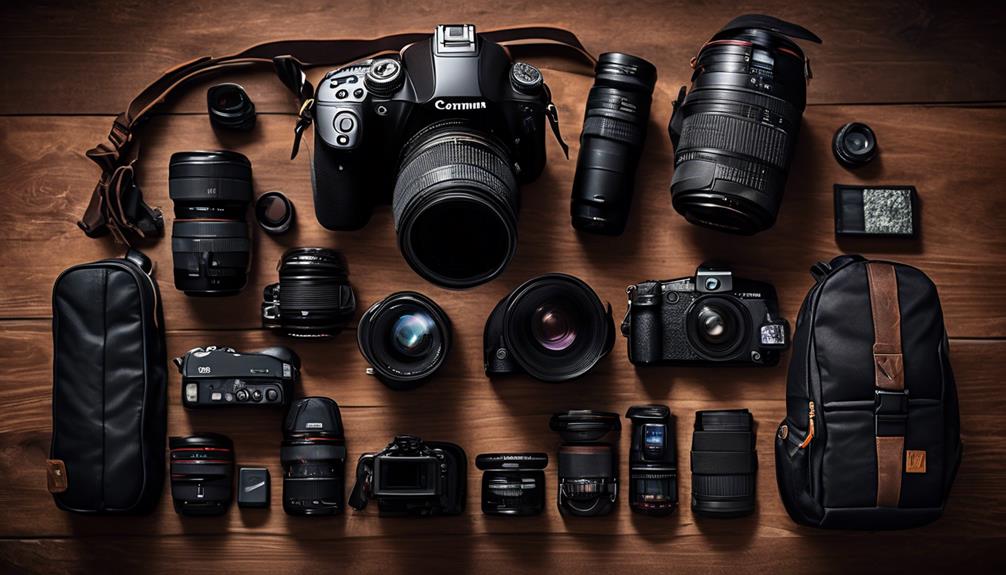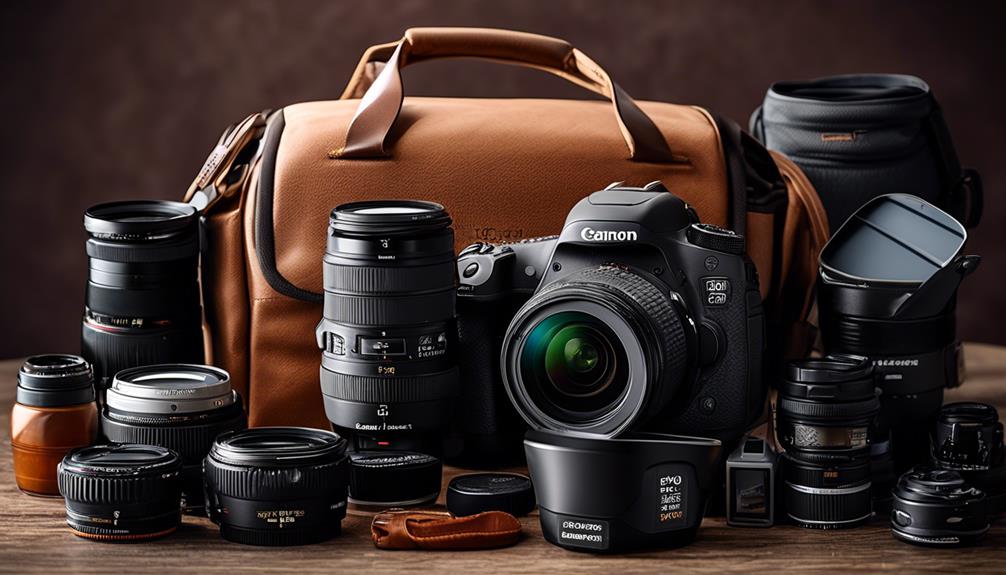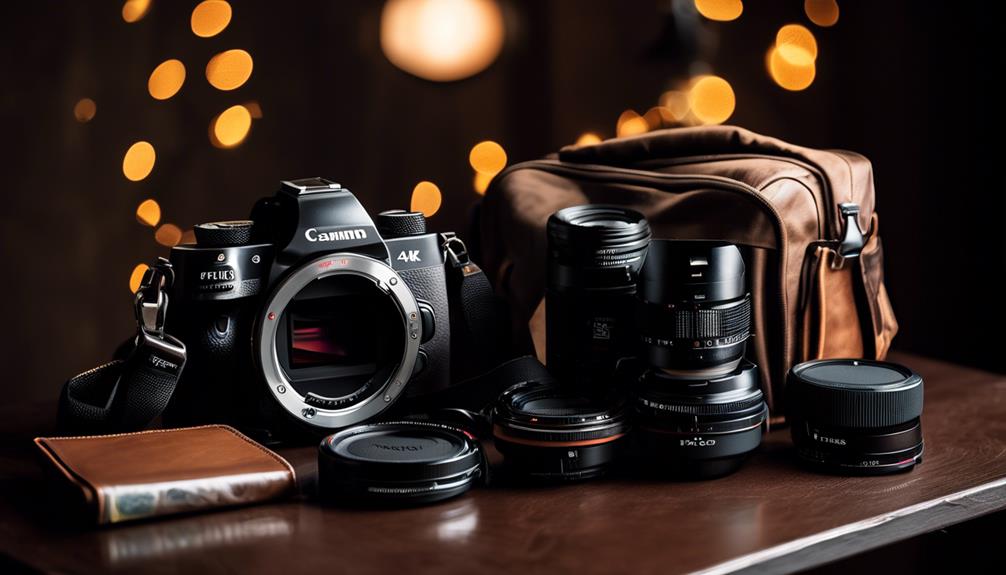Please note this post may contain affiliate links picked by me (Jay) that I have deemed may be of interest or relevant to you the reader of this.
These links do not affect the cost of the thing if you decide to purchase but i may get a little money if you choose to purchase.
For more information on my affiliate link policy click here.
As I stood on the edge of a breathtaking mountain range, camera in hand, I couldn't help but marvel at the beauty that lay before me. Capturing this moment, this feeling, required more than just a simple click of a button. It required the right gear, the right tools to bring out the best in my photography.
If you're a newbie like me, navigating the world of photography gear can be overwhelming. But fear not! In this discussion, I will share with you my top picks for photography gear that will elevate your skills and help you capture moments that will leave you in awe.
So, let's dive in and discover the essential gear that every newbie photographer should have in their arsenal.
Key Takeaways
- When selecting a camera body, consider factors such as sensor size, image quality, low-light performance, and depth of field control. Full-frame sensors offer exceptional image quality and low-light capabilities, APS-C sensors provide a good balance between image quality and affordability, and Micro Four Thirds sensors deliver impressive results in terms of portability and versatility.
- Prime lenses offer exceptional image quality and low-light performance, while zoom lenses provide versatility with a range of focal lengths. Wide-angle lenses capture a wider field of view and emphasize depth. Standard prime lenses like 50mm or 35mm are great for everyday photography and portraits, while general-purpose zoom lenses like 24-70mm or 18-135mm are perfect for travel and everyday use.
- When selecting a tripod, consider factors such as weight, portability, material, and maximum load capacity. Lightweight and compact options are ideal for easy transportation. Carbon fiber or aluminum tripods offer a good balance between weight and stability. Make sure the tripod can support the weight of your camera and additional equipment. Fully extend the legs and center column for maximum stability, and use a remote shutter release or self-timer function to eliminate camera shake.
- Lighting equipment is crucial in photography for creating stunning and dramatic effects. External flashes allow you to control the direction and intensity of light, while LED continuous lights offer adjustable brightness and color temperature for various types of photography. Light reflectors can bounce and redirect light, fill in shadows, and create a balanced image. Additionally, post-processing software can enhance lighting and colors digitally.
Camera Body: Finding the Right One
When it comes to finding the right camera body, there are a few key factors to consider before making your final decision. One of the most crucial aspects to understand is the camera sensor size. The sensor is the heart of your camera, responsible for capturing light and creating the image. Different sensor sizes offer varying levels of image quality, low-light performance, and depth of field control.
The most common sensor sizes you'll encounter are full-frame, APS-C, and Micro Four Thirds. Full-frame sensors, like the ones found in professional DSLRs, offer exceptional image quality and low-light capabilities. APS-C sensors, typically found in entry-level DSLRs and mirrorless cameras, provide a good balance between image quality and affordability. Lastly, Micro Four Thirds sensors are smaller but still deliver impressive results, especially in terms of portability and versatility.
When choosing the right camera body, it's essential to consider your specific needs and shooting style. If you're a professional looking for the utmost image quality and control, a full-frame camera might be the way to go. However, if you're just starting or on a budget, an APS-C or Micro Four Thirds camera can still produce excellent results without breaking the bank.
Additionally, you should also consider factors like ergonomics, user interface, and compatibility with lenses and accessories. These elements can greatly impact your overall shooting experience and the system's potential for future growth and expansion.
Lens Selection: Start With Versatile Options
Now that you have a better understanding of camera bodies and their sensor sizes, let's move on to the next essential aspect of photography gear: lens selection. The right lens can make all the difference in capturing stunning images, and as a newbie, it's important to start with versatile options that allow you to explore different styles and techniques.
Here are three lens choices to consider:
- Prime Lenses: Prime lenses are known for their fixed focal length, which means they don't zoom in or out. While this may seem limiting at first, prime lenses offer exceptional image quality and low-light performance. They also encourage creativity by forcing you to physically move to compose your shots. Start with a standard prime lens, like a 50mm or 35mm, which is great for everyday photography and portraits.
- Zoom Lenses: Unlike prime lenses, zoom lenses offer a range of focal lengths, allowing you to zoom in and out without changing lenses. This versatility makes them ideal for a variety of shooting situations, from landscapes to sports photography. Consider a general-purpose zoom lens, such as a 24-70mm or 18-135mm, which covers a wide range of focal lengths and is perfect for travel and everyday use.
- Wide-angle Lenses: Wide-angle lenses have a shorter focal length, enabling you to capture a wider field of view. They're great for landscapes, architecture, and interior photography, as they can emphasize depth and create a sense of scale. Look for a wide-angle zoom lens, like a 10-20mm or 16-35mm, to capture stunning wide shots and add a unique perspective to your images.
Tripod: Stability for Sharp Images
To capture sharp images and ensure stability while shooting, a tripod is an essential tool for photographers of all skill levels. When it comes to choosing the best fit tripod for your needs, there are a few key factors to consider.
First, consider the tripod's weight and portability. If you're frequently on the go, a lightweight and compact tripod will be your best friend. Look for tripods made of carbon fiber or aluminum, as they offer a good balance between weight and stability. Additionally, consider the maximum load capacity of the tripod. Make sure it can support the weight of your camera and any additional equipment you may use, such as telephoto lenses or external flashes.
Next, let's talk about tripod techniques that can help maximize stability for better shots. One important technique is to extend the legs and center column fully to ensure maximum stability. This will help prevent any camera shake caused by the tripod's movement. Additionally, using a remote shutter release or the self-timer function on your camera can further eliminate any potential vibration caused by pressing the shutter button.
Another technique to consider is using a tripod with a hook at the bottom of the center column. This hook allows you to hang weights, such as your camera bag, to add extra stability. This can be especially useful in windy conditions or when shooting in uneven terrain.
Lighting Equipment: Enhancing Your Shots
Continuing our exploration of essential gear for newbie photographers, let's shed some light on the importance of lighting equipment in enhancing your shots. Lighting plays a crucial role in photography, allowing you to create stunning and dramatic effects that can elevate your images to a whole new level. To achieve this, here are three essential lighting equipment options that every newbie photographer should consider:
- External Flash: An external flash is a versatile tool that helps you control the direction and intensity of light. By bouncing the flash off walls or ceilings, you can create soft, diffused lighting that adds depth and dimension to your subjects. With the ability to adjust the flash output and use different modifiers, such as diffusers or gels, you can experiment with various lighting techniques to achieve the desired mood and atmosphere in your photos.
- LED Continuous Lights: LED lights are a popular choice for both photography and videography. They provide a constant source of light, allowing you to see the lighting effects in real-time. LED lights are adjustable in terms of brightness and color temperature, giving you full control over the lighting conditions. Whether you're shooting portraits, still life, or even product photography, LED continuous lights offer a convenient and efficient way to illuminate your subjects.
- Light Reflectors: Reflectors are an inexpensive yet effective tool to manipulate natural or artificial light. These versatile accessories come in various shapes and sizes, such as round, oval, or rectangular, and are usually coated with different colors or surfaces. By positioning reflectors strategically, you can bounce and redirect light onto your subject, filling in shadows, and creating a more balanced and evenly lit image.
While lighting equipment plays a crucial role in capturing great shots, it's also important to consider post-processing software to enhance your images digitally. With the right software, you can fine-tune the lighting and colors of your photographs, bringing out the details and creating a professional finish.
Accessories: Must-Haves for Every Beginner
As a newbie photographer, there are a few must-have accessories that will enhance your photography skills and take your images to the next level.
Two essential accessories that every beginner should invest in are editing software and a camera bag.
Editing software is a powerful tool that allows you to enhance your photos post-shoot. It gives you the ability to adjust exposure, color balance, and even remove unwanted elements from your images. With the right editing software, you can transform your ordinary snapshots into stunning works of art. There are many options available, ranging from free software like GIMP to professional-grade programs like Adobe Photoshop. Find one that suits your needs and start exploring the endless possibilities of post-processing.
Another important accessory is a camera bag. It may seem like a basic item, but having a reliable and well-designed bag can make a big difference in how you protect and carry your gear. Look for a bag that offers sturdy padding to safeguard your camera and lenses from accidental bumps and drops. It should also have compartments and pockets to keep your equipment organized and easily accessible. Furthermore, consider the size and weight of the bag, as you'll want something comfortable to carry around during your photography adventures.
Investing in editing software and a camera bag won't only protect your gear but also enhance your overall photography experience. With editing software, you can unleash your creativity and bring out the best in your images. And a good camera bag will provide the convenience and peace of mind that comes with knowing your equipment is safe and easily transportable.
Frequently Asked Questions
Is It Necessary to Invest in an Expensive Camera Body as a Beginner?
As a beginner, investing in an expensive camera body may not be necessary. There are plenty of budget-friendly camera options that can still produce high-quality images.
It's more important to focus on understanding camera settings and techniques before upgrading equipment. By mastering the fundamentals, you'll be able to capture amazing shots regardless of the camera you're using.
How Do I Know Which Lens Is the Best Option for My Photography Needs?
When it comes to choosing the best lens for my photography needs, it's essential to consider the specific genre I'm shooting.
For landscape photography, wide-angle lenses are ideal, allowing me to capture breathtaking vistas and expansive scenes.
On the other hand, for portrait photography, a prime lens with a wider aperture can create beautiful bokeh and enhance the subject's features.
Understanding the different lens options for each genre helps me make informed decisions and elevate my photography to new heights.
Can a Tripod Be Used for Video Shooting as Well, or Is It Only Limited to Photography?
A tripod can definitely be used for video shooting as well! It's not limited to just photography.
Using a tripod for video shooting offers several benefits. It helps stabilize your shots, resulting in smoother and more professional-looking footage. It also allows you to easily pan and tilt the camera, adding movement and creativity to your videos.
However, there are some cons too, such as the added weight and bulkiness.
What Type of Lighting Equipment Is Most Suitable for Indoor Photography?
As a photography enthusiast, I've experimented with various lighting setups for indoor photography. It's fascinating how the right lighting can transform an ordinary scene into something extraordinary.
When it comes to creating professional-looking indoor lighting on a budget, there are a few tips and tricks that can make a big difference. From using natural light to affordable LED panels, the possibilities are endless.
With a little creativity and resourcefulness, you can achieve stunning results without breaking the bank.
Besides the Camera and Lens, What Are Some Essential Accessories That Every Beginner Should Consider Purchasing?
When starting out in photography, it's important to have the right gear to enhance your skills. Besides the camera and lens, there are a few must-have accessories that every beginner should consider purchasing.
Affordable alternatives like a tripod, remote shutter release, and a camera bag can greatly improve your photography experience. These accessories provide stability, convenience, and protection for your equipment, allowing you to capture stunning shots with ease.
Don't underestimate the power of these essential camera accessories for newbies.
Conclusion
After reading about the top photography gear picks for newbies, it's clear that the right equipment can truly elevate your skills. Just like a well-tuned instrument in the hands of a musician, these tools can bring your visions to life.
So whether you're capturing breathtaking landscapes or intimate portraits, invest in the gear that speaks to your creative soul. Remember, with the right gear, you'll be able to unlock a world of unlimited possibilities and capture moments that will forever stir your heart.


